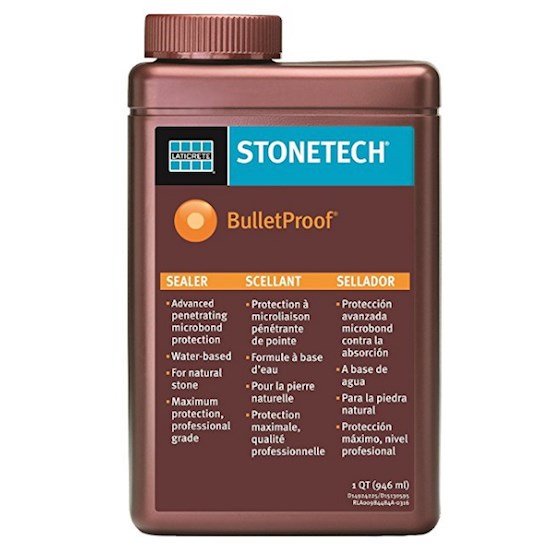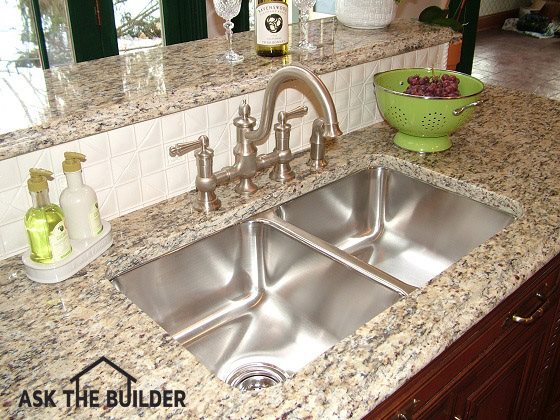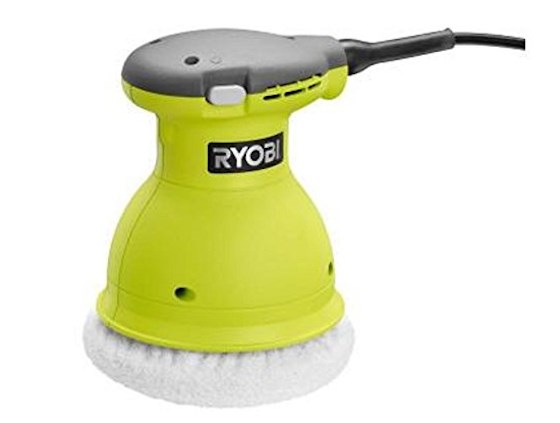How to Granite Sealer

This is the best granite sealer I've used. The BEST sealers cost the most. BEWARE of low-priced granite sealers. CLICK THE IMAGE NOW TO BUY THIS AMAZING SEALER.
"Another key point is colored fruit juices, cooking oils, grease, fats, marker pens, and anything that has color in it can seep into these small fissures and cracks. The resulting discoloration can be very difficult to remove."
Granite Sealer TIPS
- Granite sealer fills micro cracks in granite
- Common colored drinks and oil are bad
- Best granite sealer is the most expensive
- Apply to bone-dry granite - See Below
- CLICK HERE to Get Tim's FREE & FUNNY Newsletter!
DEAR TIM: I've talked to three different people about granite sealers and have received three different answers.
I'm hoping you can set me straight about if granite needs to be sealed, when it should happen, how it is done and how frequently.
The house I just purchased has granite countertops that are in great shape, and I want to keep them that way. Jennifer L., Antioch, IL
DEAR JENNIFER: It's really discouraging to get different answers from different people, but in this case, much of what you were told might be true.
What is Granite Sealer?
Granite sealer is a clear liquid that contains microscopic solids that fill invisible cracks in granite. The sealers prevent liquids from penetrating into the stone.
It's important to realize granite countertop sealers can be as varied as cars on a used car lot. Add that to the different types, colors and grain size of granite, and you have a recipe for granite-sealing information gumbo soup.
What is the Best Granite Sealer?
The best granite sealer is one made with the best ingredients. These sealers almost always are the most expensive ones you can buy. Better ingredients and more of them in the granite sealer cost the manufacturer more money.
How Does Granite Crack?
Let's first talk about granite and why it should be sealed. I knew my college degree in geology would pay off one day. The granite used for your countertops is a natural stone made up of different interlocking mineral crystals.

This is my own undermount sink at my own home. My wife loved this countertop and sink. We sold the house and moved to New Hampshire. © 2017 Tim Carter
It must be remembered that the mineralogy is vastly different from granite to granite. This difference produces the nearly infinite color ranges of granite, the size of the crystals and the porosity of the stone.
Furthermore, some granites have very small cracks in them from natural stresses that happened while the granite was still part of a mountain.
What Things Stain Granite?
Another key point is colored fruit juices, cooking oils, grease, fats, marker pens and anything that has color in it can seep into these small fissures and cracks. The resulting discoloration can be very difficult to remove.
Sealers act as a shield to prevent stains from entering the granite in the first place.
When Should Granite Be Sealed?
A point often overlooked is granite should be sealed before it's put into use. This doesn't mean the day it is installed.
Granite sealers should be applied to the polished surfaces of the granite when there's very little airborne dust.
This means that in new construction and remodeling jobs, it is best to wait until the end of the job after the final cleaning has taken place.
Someone should seal the granite the day after the cleaning crew leaves and just before the homeowner takes possession of the kitchen, bathroom or wet bar where the granite tops are installed.
How Many Coats of Granite Sealer Do I Need?
It's a good idea to apply multiple coats of granite sealer. Read the label to see how much time you need to wait in between coats.
Now, with that being said, there are small areas of the granite that should be sealed just after the granite is installed. It's a great idea to apply a sealer to the areas immediately adjacent to where faucets, sinks, and cooktops will be installed on or under the granite.
Faucets, cooktops and over-mount sinks hide small areas of granite that can be still be attacked by liquids that might seep under a seal. Apply the granite sealer to the polished surface of the granite as well as the rough cut holes and edges where these different fixtures will be installed.

This is the granite kitchen countertop in the last house I built in Cincinnati, Ohio. It was a gorgeous light granite and I sealed it to ensure there were no stains. Copyright 2017 Tim Carter
Should Existing Granite Be Sealed?
Yes, existing granite tops in a house you just moved into should be sealed immediately.
If you're moving into a previously owned home that has granite countertops, you have no clue if they were sealed. At the same time, the previous homeowner may have used a cheap granite sealer.
Be that as it may, assume the granite was not sealed and do so on move-in day. If at all possible, do it before you move in.
I realize you'll be very busy moving in, but you will regret sealing the granite if someone spills grape juice or leaves a greasy pizza box sitting on the countertops as you collapse from all of the work on move-in day.
How Long Do Granite Sealers Last?
High-quality granite sealers have a long lifespan. Some can provide protection for up to ten years.
The life expectancy of the sealer you purchase should be clearly marked on the product label. To be safe, I'd not wait until the old sealer wears off before applying additional coats.
Are Granite Sealers Easy to Apply?
Granite sealers are easy to work with. As with any specialty product, always read the application instructions, and follow them to the letter.
Does the Granite Have to be Dry?
Yes, granite sealers should be applied to dry granite. This is very important. Be aware of what dry means. This doesn't mean clean the countertop and then dry it with a paper towel.
For one thing, water from the cleaning process can seep into the granite just as a liquid that might stain it. If water is in the small cracks, fissures, and spaces between the crystals, the sealer can't penetrate into the granite.
How Long Do I Need to Wait?
Clean the granite and let it sit for 24 hours or allow a fan to blow across the granite for eight hours. Wet granite has a richer color than dry granite, so wait for the granite to get that faded look before opening the sealer.
Is Buffing Granite a Good Idea?
Yes, buffing the granite creates a wonderful shine. Buff the granite with an old terry-cloth bath towel after the sealer dries. These rough cloths do a fantastic job of making the granite shine.
Cordless orbital buffers will really make this buff job easy.

This is an affordable orbital buffer. It's not meant to use everyday. It will polish your granite top with ease. CLICK THE IMAGE NOW TO ORDER IT.
Column 664
10 Responses to How to Granite Sealer